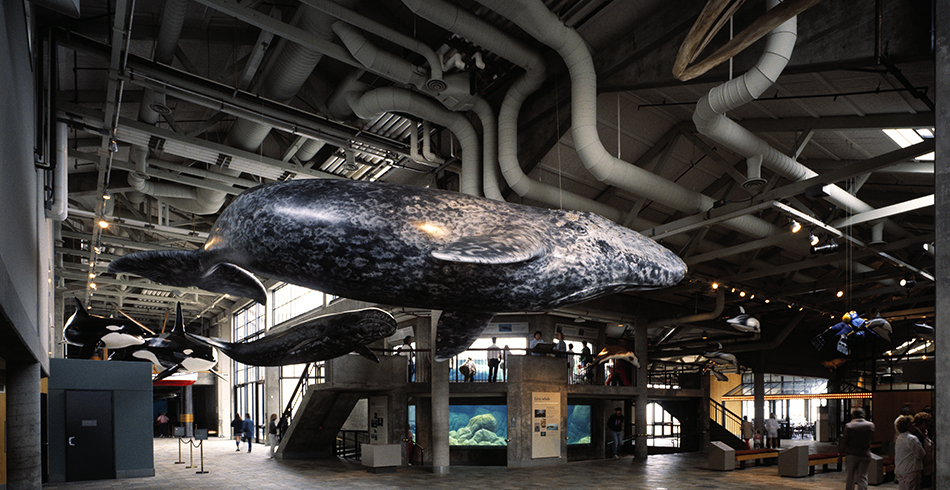Buildings with Pipes

San Francisco Beer Week kicks off on February 10th and opens with a large gathering of makers and craftspeople and their brews, all eager to share them with each other and the public. EHDD has a long history of working with clients that are makers, and for decades we have been designing technically demanding buildings and spaces for specialized uses, including laboratories, aquariums, zoos, museums, and breweries.
We love buildings that expose their inner workings—the miles of pipes, conduits, ducts and raceways that form the circulatory system of the living building. A lot of pipes make up the circulatory system that delivers nutrients to keep fish alive at an aquarium, delivers flour and water to a bakery, and conveys ingredients and water to the brew house at a brewery.
Keeping Creatures Alive
The Monterey Bay Aquarium has been often imitated, but seldom replicated as successfully as it was on Cannery Row. The shark and the diminutive jellyfish, both residents of EHDD’s first aquarium, are somewhat akin to astronauts living in a space station. They are restrained by an artificial environment that keeps them alive by successfully recreating a self-contained and hospitable environment. Like a space station, an aquarium provides the good stuff to keep its residents alive, while keeping out or removing the bad stuff that would cause them harm. Many miles of pipes, conduits, cabling and tanks are required to make this work at an aquarium.
Monterey Bay Aquarium is a case study of specialized technical issues and the large network of pipes that define marine research facilities, including acquiring process water, stabilizing water temperatures, preventing algae growth, structurally sound display tanks, complicated filtration systems, animal husbandry areas, and associated labs and shop spaces.
If you Bake it, They will Come
Like Cannery Row in Monterey, Fisherman’s Wharf in San Francisco oozes history and is packed year-round with hordes of visitors looking for crab, sourdough bread and an Alcatraz sweatshirt. Boudin is a legacy San Francisco business that has been making and selling sourdough bread with the same starter yeast since the California gold rush of 1849.
EHDD designed Boudin at the Wharf, a two-story, 25,500 sf building on the site of Boudin’s old bakery and café at Fisherman’s Wharf. The complex encompasses a working bakery, associated retail, a cafe, and a second floor bar and restaurant. The design showcases the baking process with views into the bakery, both from within the building and from outside on the sidewalk, and allows visitors to take a self-guided Bakery tour of exhibits and the chance to look down on the activity of the bakery below.
The working flour silo attached to the end of the building stands as the literal and functional symbol and sign post for the bakery, receiving the flour deliveries and conveying it through pipes into the bakery to make more baguettes.
Beer Here
Breweries are all about moving large amounts of fresh, potable water through pipes into a building for making beer, and then moving large amounts of a finished liquid product to a cellar and on to a bottling line. Most breweries and bakeries (that are larger than a neighborhood shop) also receive daily deliveries of grain and/or flour. Beer is a living thing, and the pipes and plumbing that make the brewing process work are, in concept, not too dissimilar to the life-support plumbing that keeps the fish alive at the aquarium.
Anchor Brewing & Distilling, like Boudin, is another legacy “pre-quake” San Francisco business and EHDD client and neighbor. We have worked for big craft breweries like Anchor and New Belgium and for micro-brewers like Great Northern in Montana. For the most part, Anchor uses gravity to move things through their pipes and down the line, from the mash tun to the kettle, to the fermentation tanks to the cellar, and on to the bottling and keg lines.
As SF Beer Week approaches, we are excited to be working with Anchor Brewing again to help them create a smaller-scale brewing set-up that will allow their brewers and tinkerers to experiment with new recipes quickly and efficiently, and also enable them to share it with their neighbors and visitors more easily. More pipes and tanks will be involved!


